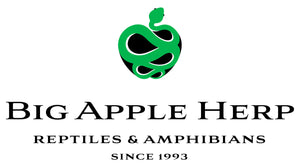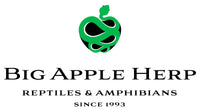Care Sheet for Hermit Crabs
Hermit crabs in their native environment live inland away from the water and the beach. Their diet consists of leaf litter, fruits and vegetation. They also enjoy chewing and eating bark and have a special preference for decaying wood (except pine or cedar.) When they have been domesticated it is recommended that they be fed a good commercial food and on alternate days treats may be fed, or coconut, romaine lettuce, apple, white bread, popcorn with or without sea salt, etc. It is recommended to offer oyster shell, egg shell, calcium block or cuttlebone for a calcium source. Land hermit crabs eat very slowly and very little so all uneaten food which lies outside of the food dish should be removed daily to avoid spoilage.
Water Quality is a must. To provide the necessary moisture for your hermit crabs, it is important to bathe this little friend. In climates which are humid, once a week, in summer, twice a week, in winter bathing once a week will be sufficient. In climates that are arid or when very dry heat provides warmth for your house, bathing every other day is preferable. Misting your hermit crabs on a daily basis outside the tank may be substituted for the bathing routine. Providing water in which the crab may climb is important. Use a non metallic container. A small sponge should be placed in the container to provide safety and prevent possible drowning. Water quality is a must. Our rule of thumb is, if the available water supply is acceptable for keeping aquarium fish, it is acceptable for hermit crabs. If you must treat the water for fish, treat the water for hermit crabs. Hard water with high iron content can do the most damage to your hermit crab. Bottled spring water is the safest.
Crabs can be kept in a plastic terrarium or aquarium with a 2 inch base of gravel or sand. The temperature should be maintained between 70 and 75 degrees. A heater can be purchased and placed under the aquarium to maintain the temperature above 70 degrees when one's home is programmed to remain in the 60's. We do not recommend using a full spectrum lights or heat bulbs on the aquarium or the use of corn cob or cedar shavings. This tends to dry out the hermit crabs and/or dehydrate them. If temperatures consistently are allowed to rise to the high 70 degrees or 80 degrees F, fresh air flow is needed. This can be provided by the use of an aquarium air pump accessory.
Hermit crabs are not aggressive like many of the sea crabs and can be handled. They climb on the outstretched palm of your hand without difficulty but avoid the large purple pincher claw which is used for defense and for holding onto limbs for climbing and balancing. If one is unfortunate enough to have a crab pinch the skin, place the area where the pincher and the skin meet under hot water. The pincher will normally turn lose immediately. The smaller claw is used to pass food and water to the mouth. The name "Hermit" is misapplied, for in the wild they live and travel in colonies of a few dozen to over a hundred. It is recommended that in captivity they be kept in the company of other crabs for their own contentment. They communicate by sound and it is not uncommon to hear them "talking" to each other. They seldom fight, except occasionally over a shell or gender dispute. They are clean and odorless and may be released in the home for exercise and for observation of their comical antics if desired. They are good climbers and will enjoy coral or any type of non-resinous wood placed in their aquarium to exercise on. Like most other creatures, they respond to gentle care and learn to trust their keeper. It is known that some crabs have been kept in the home as pets for over 30 years.
Land hermit crabs have not reproduced in captivity. Their eggs need to be fertilized by salt water. Hermit crab enthusiasts are optimistic propagation in captivity will allow for reproduction. Like other crabs they grow by shedding their outer exoskeleton. This is the most important step toward growth a small crab will make. During this time they shed all their skin (which looks like an empty skeleton of a crab.) They need to be kept extra moist and in a medium into which they can burrow themselves. It also may be necessary to isolate the crab for a couple of days because they are very soft, vulnerable and inactive. However this is an important stage of development for it is in this period that any missing legs, etc., are regenerated by the crabs. Older crabs molt less frequently but require the same care. As the crabs grow they will need spare shells to grow into and they also seem to enjoy moving into empty shells to select the home that feels best. It is advisable to NEVER attempt to remove a crab from its sea shell because it will allow itself to be torn apart rather than give up it's protectivehome.
Stress is the most common problem seen with hermit crabs. Ramifications of stress are lethargic crabs, loss of appendages (legs and claws), and those which leave their shell without returning to it. If these symptoms occur, a tetracycline solution must be administered to the crab.
It is also comforting to know that hermit crabs do not carry or transmit any knowndiseases to mankind and they are hypo-allergenic, great as a pet for those with or
without allergies.


